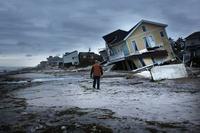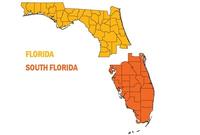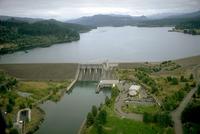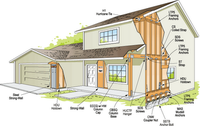-
Georgia Tech releases 2015 Emerging Cyber Threats Report
In its latest Emerging Cyber Threats Report, Georgia Tech warns about loss of privacy; abuse of trust between users and machines; attacks against the mobile ecosystem; rogue insiders; and the increasing involvement of cyberspace in nation-state conflicts.
-
-
Many victims of Hurricane Sandy are still waiting for government aid

It has been two years since Hurricane Sandy destroyed thousands of homes and businesses along the Jersey Shore yet many affected homeowners are still waiting for federal and state aid to rebuild. Of the $3.26 billion the U.S. Department of Housing and Urban Development (HUD) has provided to New Jersey, only $802 million has been paid out as of 30 September. The federal government’s first allocation of Sandy funds to New Jersey came seven months after the storm. The state has yet to issue any of the $1.46 billion approved by HUD in May, and New Jersey officials expect a final round of $880 million next spring.
-
-
State regulators discuss the connection between fracking and earthquake
Regulators from states with significant petroleum and natural gas exploration activities met last week in Columbus, Ohio as part of the 2014 Interstate Oil and Gas Compact Commission conference.One key topic of discussion at the conference wasthe potential implications of a study which found that numerous, unnoticeable earthquakes in Harrison County, Ohio, likely were linked to oil and natural gas exploration. 190 of the quakes which ranged from magnitude 1.7 to 2.2, occurred in the thirty-nine hours after fracking activity occurred at one well in late September and early October 2013.
-
-
States invest in resilience in the face of mounting extreme-weather challenges
Months after Superstorm Sandy devastated the New York coast line, Governor Andrew Cuomo’s Office of Storm Recovery launched a $17 billion strategy to transform the state’s infrastructure. Project Reimagining New York for a New Reality sought to make the state’s transportation networks, energy supply, coastal protection efforts, weather warning systems, and emergency management more resilient. The strategy is just one example of a trend in investments toward resilience efforts post Hurricane Katrina, Irene, Lee, and Sandy.
-
-
Building a network of canals to save Boston from sea level rise
By the end of the century, sea-level rise on the U.S. east coast is predicted to reach six feet, so city planners in Boston recently met to discuss how to live with rising waters along the city’s historic streets. One suggestion is to turn Boston’s Back Bay district into a network of canals. The canals would alleviate sea-level rise by draining water into lower-lying back alleys and some main streets, but the proposed plan would have to contend with freezing temperatures in the winter.
-
-
Effective, inexpensive method to detect natural gas pipeline leaks
Major leaks from oil and gas pipelines have led to home evacuations, explosions, millions of dollars in lawsuit payouts, and valuable natural resources escaping into the air, ground and water. Scientists say they have developed a new software-based method that finds leaks even when they are small, which could help prevent serious incidents — and save money for customers and industry.
-
-
South Florida wants to secede from Florida over sea level rise

When people talk of “secession” in the United States they typically have Texas, Vermont, or the former Confederate states in mind, and the reasons for driving secession typically have to do with politics or money. Not anymore. The city of South Miami earlier this month passed a resolution which called for southern Florida to secede from the rest of the state, citing climate change as the reason. There are many differences between north and south Florida: South Florida is largely urban and politically tends to lean left, while the north is mostly rural and much more conservative. If south Florida reminds people of New York, the Florida panhandle resembles Alabama. Then there is this: The northern part of the state is, on average, 120 feet above sea level, but much of the southern section averages only fifteen feet above sea level. South Floridian say that the state government in Tallahassee ignores the perils of sea level rise, which are particularly acute in south Florida, so the time has come to separate from the aloof north.
-
-
China steals confidential data on the vulnerabilities of major U.S. dams

The U.S. Army Corps of Engineers’ National Inventory of Dams(NID) contains critical information on the vulnerabilities of the roughly 8,100 major dams in the United States. Between January and April 2013, U.S. intelligence agencies spotted several attempts by China’s People’s Liberation Army (PLA) cyber-espionage unit to access the NID database and steal its contents. On Monday, National Weather Service (NWS) hydrologist Xiafen “Sherry” Chen, 59 was arrested for allegedly breaching the NID security and stealing confidential data on U.S. dam vulnerabilities. The Justice Department has raised the alarm over multiple attempts by China to steal data on U.S. critical infrastructure through individuals with privileged access to confidential databases.
-
-
U.S. planning expansion of nuclear production in the face of safety concerns

Despite the release of a damning report regarding the 14 February nuclear waste accident at the Waste Isolation Pilot Plant (WIPP) near Carlsbad, New Mexico by the U.S. Department of Energy (DOE), the government is planning ramped-up production of nuclear weapons cores, a move which is raising red flags for those calling for reform of nuclear production and storage procedures.
-
-
Sea level rise or not, coastal development in south Florida is booming
Miami and Miami Beach are both considered ground zero for the challenges posed by climate change, as both cities will experience considerable sea level rise by mid-century. Constant flooding will become the norm as high tides reach shores, posing a threat to property and human life. As discouraging as the future may seem for South Florida, residents, real estate investors, and companies are increasing their investments in the area.
-
-
Retrofitting old buildings to make them earthquake safe
Non-ductile reinforced concrete buildings are among the most common structures in the United States. They are also among the most deadly. Structures built prior to the 1950s in California and prior to the 1980s in the central and southeastern United States were typically not designed with proper details to perform adequately during earthquakes. Through a grant provided by the National Science Foundation, researchers are testing retrofits that potentially can make these buildings safer and more secure.
-
-
Global surge of great earthquakes from 2004 to 2014: Implications for Cascadia
The last ten years have been a remarkable time for great earthquakes. Since December 2004 there have been no less than eighteen quakes of Mw8.0 or greater — a rate of more than twice that seen from 1900 to mid-2004. Hundreds of thousands of lives have been lost and massive damage has resulted from these great earthquakes. As devastating as such events can be, however, these recent great quakes have come with a silver lining: They coincide with unprecedented advances in technological and scientific capacity for learning from them.
-
-
Getting the salt out
The boom in oil and gas produced through hydraulic fracturing, or fracking, is seen as a boon for meeting U.S. energy needs. But one byproduct of the process is millions of gallons of water that’s much saltier than seawater, after leaching salts from rocks deep below the surface. Study shows electrodialysis can provide cost-effective treatment of salty water from fracked wells.
-
-
California earthquake early warning system set to go online in 2016
Disaster management officials in California are reporting that a new earthquake early-warning system will be online in the state within the next two years. A bill mandating the system was passed in January under Senate Bill 135, requiring the state’s Office of Emergency Services (OES) to develop a statewide system that can alert Californians before dangerous shaking with a ten second window. The funding for the project is $80 million for the first five years.
-
-
Engineers build, test earthquake-resistant house

Residential homes already do a good job of keeping the people inside safe when a temblor hits. Earthquakes, however, typically do a lot of minor structural damage. For example, after the 1994 Northridge quake, the majority of the $25.6 billion in repair costs paid for fixes to 500,000 residential structures. Most of those homes were not destroyed, but nonetheless thousands of families had to find a new place to live while their houses were repaired. Twenty-five years after the 1989 Loma Prieta earthquake, Stanford engineers have built and tested an earthquake-resistant house that stayed staunchly upright even as it shook at three times the intensity of that destructive temblor. The engineers developed inexpensive design modifications that could be incorporated into new homes to reduce damage in an earthquake.
-
More headlines
The long view
Helping Strengthen America’s Critical Infrastructure
Everyday life depends on a robust infrastructure network that provides access to running water, communications technology and electricity, among other basic necessities. The experts who keep our national infrastructure secure and resilient also need a strong network to share their knowledge and train the next generation of professionals capable of solving complex infrastructure challenges.
AI and the Future of the U.S. Electric Grid
Despite its age, the U.S. electric grid remains one of the great workhorses of modern life. Whether it can maintain that performance over the next few years may determine how well the U.S. competes in an AI-driven world.
Using Liquid Air for Grid-Scale Energy Storage
New research finds liquid air energy storage could be the lowest-cost option for ensuring a continuous power supply on a future grid dominated by carbon-free but intermittent sources of electricity.
Enhanced Geothermal Systems: A Promising Source of Round-the-Clock Energy
With its capacity to provide 24/7 power, many are warming up to the prospect of geothermal energy. Scientists are currently working to advance human-made reservoirs in Earth’s deep subsurface to stimulate the activity that exists within natural geothermal systems.
Experts Discuss Geothermal Potential
Geothermal energy harnesses the heat from within Earth—the term comes from the Greek words geo (earth) and therme (heat). It is an energy source that has the potential to power all our energy needs for billions of years.
